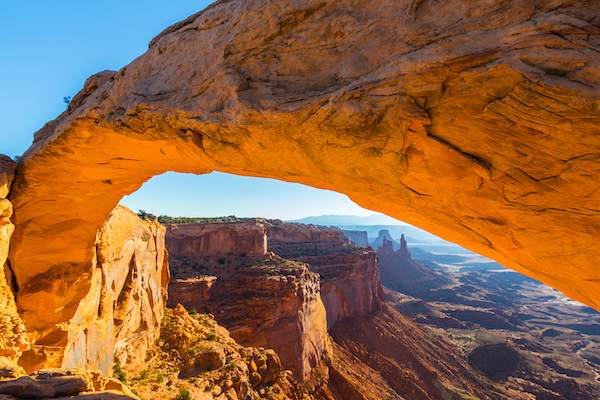
What to see and do in Canyonlands National Park

Utah's breathtaking Canyonlands National Park sits in the state's southwestern corner. The canyons, mesas, and rock formations in this national park are very breathtaking.
To make the most of your trip, this comprehensive guide will include must-see attractions, fun things to do, and useful tips. No matter if you're a hiker, a nature lover, or just searching for breathtaking views, this article will help you arrange a trip you'll never forget.
Getting in the Park
 Shutterstock Image
Shutterstock Image
Here you may purchase your entry ticket to Canyonlands National Park. Some holidays do not require a pass. America the Beautiful Annual Passes are accepted.
Park Overview
Canyonlands consists of 3 districts known as:
- Island in the Sky
- The Needles
- The Maze
The most central and easily accessible area of the park is Island in the Sky, which is home to Mesa Arch. In contrast, The Needles and The Maze are further away and provide more difficult trails. Read on for info on the three Canyonlands areas.
Hiking and Backpacking
 Chesler Park / Image from Flickr by CanyonlandsNPS
Chesler Park / Image from Flickr by CanyonlandsNPS
The best views, canyons, and rock formations of Canyonlands are only accessible by foot. These trails bring the outdoors closer:
1. Chesler Park Loop
- Distance: 5.8 miles
- Difficulty: Strenuous
The Needles District is home to beautiful rock formations, miniature slot canyons, and expansive meadows with breathtaking panoramas, all of which may be seen on this fantastic lollipop loop walk.
2. Mesa Arch Trail
- Distance: 0.5 miles
- Difficulty: Low
You can enjoy the sunrise or sunset over the canyons from Mesa Arch, which is a short walk from the rest of the Island in the Sky District.
3. Syncline Loop
- Distance: 8.1 miles
- Difficulty: Strenuous
This challenging loop hike in the Island in the Sky District takes you down into the canyons around Upheaval Dome and over barren boulder fields, where you'll be rewarded with stunning views of the surrounding canyons and buttes and interesting geological formations.
Wildlife and Nature
Plants and animals prosper despite the dry climate. It's possible to spot the following wildlife:
Desert Bighorn Sheep

The world-famous Canyonlands bighorn sheep. Robust, with horns that curve and hair that ranges from tan to a deep crimson. Horns on rams tend to be larger, but females have horns, too. They're agile and skilled rock climbers. Desert bighorn sheep like rocky, vertical terrain. Look for them in the chasms, the hills, and the sea.
Black-tailed Jackrabbit
The black-tailed jackrabbit has large ears, bluish-gray hair, and a black-tipped tail. Their speed in the desert is aided by their long, powerful hind legs. Several habitats for black-tailed jackrabbits may be found in the park. Mornings and evenings seem to find them at their most active.
Collared Lizard
 Image from Flickr by CanyonlandsNPS
Image from Flickr by CanyonlandsNPS
The western collared lizard is a vibrantly colored reptile. It finds itself in stark contrast to the red desert surrounding it. However, it feels perfectly at home amidst the dramatic red rock canyons and arid landscapes of Arches National Park.
Its distinctive black bands around its neck make it easily recognizable. Agile and quick, however, it can be difficult to spot! One can see it darting across rocks and basking in the warm sun to keep itself warm.
Be on the lookout for them and the other 900 or so plant and animal species that call this park home!
Safety and Preparedness
The Canyonlands are stunning, but they may be dangerous for the unprepared. Some Precautions to consider:
1. Stay on designated trails
Stay on established trails to protect the delicate desert ecosystem from damage.
2. Carry and drink plenty of water
Canyonlands is hot and dry, so be sure to drink plenty of water. Always take lots of water with you on walks of any length.
3. Check weather conditions
Before setting out, make sure to check the forecast. Expect unexpected storms, high winds, and cold weather.
4. Protect yourself from the sun
Put on a brimmed hat, some shades, and some light clothes that conceal your skin. Sunscreen should be worn and reapplied even on cloudy days.
5. Inform others of your plans
Tell someone where you want to hike and about how long it will take you to get back. If there is a problem, people will notice.
6. Be mindful of wildlife
Don't approach animals or feed them. Staying away will keep animals from becoming alarmed.
7. Carry essential supplies
You should include:
- map
- compass
- flashlight
- Emergency Medical Kit
- a whistle
and some additional provisions. In times of crisis, these supplies are necessary.
8. Follow park regulations
Be mindful of the park's laws regarding fires, dogs, and tents. All park resources and visitor security will be protected thanks to these rules.
Leave no trace behind and observe the park's safety regulations to ensure the park remains accessible for years to come.
Conclusion
 Deadhorse Point / Shutterstock Image
Deadhorse Point / Shutterstock Image
Canyonlands National Park is home to beautiful landscapes, thrilling treks, and an ecologically rich setting. It's a great place to spend some time.
Canyonlands is a must-see for any traveler to the Southwest who is interested in seeing the region's diverse landscapes and fascinating geological formations.
Make travel arrangements, pack your bags, and get ready to discover this magnificent national park. Join us on a tour of Canyonlands National Park and discover all there is to see.

Ellie Lewis is currently studying Journalism at BYU with a minor in Editing & Publishing. Born and raised in San Diego, Ellie has always had an interest in storytelling and all forms of media creation.
At Shaka Guide, she's a true jack of all trades—contributing to everything from simulating tours and writing articles to managing content logistics and data organization. Ellie’s travel bucket list remains... long.
We hope that we’ve given you all the information you need to make the most of your day. Your vacation is extremely important to us so if you have any questions feel free to reach out at aloha@shakaguide.com.
For more detailed information to help you plan, check out our Canyonlands National Park Itinerary and Know Before You Go article.
Like this article? Share it on Pinterest!

RELATED ARTICLES:
Weather in Canyonlands - When's the Best Time to Visit?
Best Scenic Overlooks in Canyonlands both Sunrise and Sunset


























 to fuel your ride
to fuel your ride 
